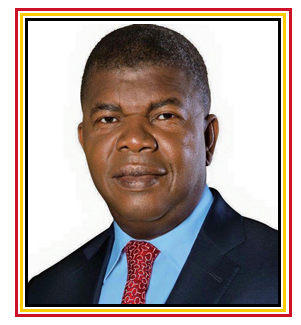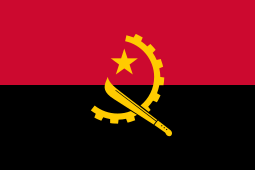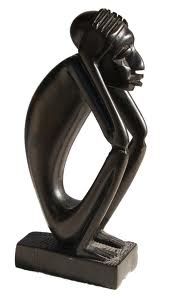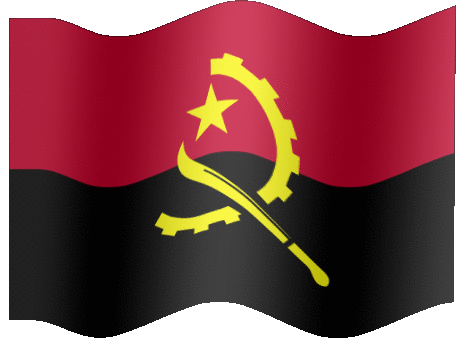- Details
- Category: Angola General Information
Angola is located in the western region of Southern Africa, with the following geographical data:
- Area: 1,246,700 square km
- Extension of the Atlantic Coast: 1,650 Km
- Land Frontiers: 4,837 Km
- Countries bordering North: Republic of Congo and Democratic Republic of Congo.
- Countries bordering East: Democratic Republic of Congo and Republic of Zambia.
- Countries bordering South: Republic of Namibia.
- West: Atlantic Ocean.
Angola has 18 provinces. The city of Luanda with around 8 million inhabitants is the capital of the country.
Approximately 65% of the territory is situated at an altitude between 1000 and 1600 meters.
The official currency is the Kwanza (Kz) ($ 1 = 507,13 Kz – January 2023)
The official language is Portuguese, besides several national languages (dialects), being the most spoken: Kikongo, Kimbundo, Tchokwe, Umbundo, Mbunda, Kwanyama, Nhaneca, Fiote, Nganguela, etc.
Government

The current political regime in Angola is presidential, in which the President of the Republic is also head of the Government
Legislative Branch - Unicameral - National Assembly with 220 members of parliament, distributed as follows:
MPLA party - 124 members
UNITA Party - 90 members
PRS Party - 2 Members
FNLA Party - 2 members
PHA Party – 2 members
President of the Republic - João Manuel Gonçalves Lourenço (second term of 5 years since September 2022)
Vice-President of the Republic – Dr. Esperança da Costa
President of the National Assembly – Dr. Carolina Cerqueira
Other relevant data
Population – 33.097.671 - 48% male and 52% female
Unemployment rate – 30.2% (2022)
Inflation Rate – 15,247% (2022)
GDP - USD 124,8 billion (expectation 2023)
Economic growth rate: 2,8% (2023)
GDP Per Capita - $ 3.300 (2022)
Life Expectancy - 60.2 years
Religion - Christians 79% of the population
Average age - 20.6
Oil production in 2022 – 1.174.410 barrels per day (one million, one hundred and seventy four thousand and four hundred and ten) - Is the second largest producer of oil in sub-Saharan Africa after Nigeria.
Diamond production in 2022 – 10,5 million carats - It is the fifth largest producer of diamonds in the world.
Agriculture - Angola has an availability of 35 million hectares of arable land, of which only five million are already cultivated. Angola also has extensive pasture areas for livestock production, an irrigable area of seven million hectares of its total area, of which 3.4 million are traditional.
Weather
The climate in Angola has two seasons: the rainy season, the hottest period between September and May, and that of Cacimbo. The Cacimbo or Drought is less hot and runs from May to September.
The average Temperatures of the country are: 27 ° C maximum and 17 ° C minimum
Rivers
Angola has 77 rivers, 47 of which are major and 30 are secondary. The main rivers are:
- The Kwanza river, which gives the name to the national currency with 1000 km of longitude, but only 240 km are navigable;
- The Kubango river with 975 km;
- The Cunene river with 800 km;
- The Congo river 150 km of longitude, the latter being all navigable.
Angola has also lakes and lagoons, being the main lake of Angola, the Dilolo in the Province of Moxico in the Eastern region of the Country and the most important lagoons, those of the Panguila and Muxima both in the Province of Luanda.
In the affluent of the Kwanza, Lucala, are the famous Falls of Calundula, with more than 100 meters of height. In addition to these, there are several falls and rapids in other rivers.
Angolan rivers, lakes and lagoons offer opportunities for the implementation of tourist-interest or mixed trade-tourism types or the practice of eco-tourism.
Mineral resources
Angola is a country potentially rich in mineral resources. It is estimated that its sub-soil is home to 35 of the world's 45 most important trade fairs, including oil, natural gas, diamonds, phosphates, bituminous substances, iron, copper, magnesium, gold and ornamental stones.
With immense natural resources, this climatic diversity results in a natural heritage in rich and varied flora and fauna. We must not forget the Namib Desert where there is a unique and endemic plant species in the world that characterizes this country "Welwitchia Mirabilis", in the Maiombe forest in Cabinda, where gorillas, chimpanzees and parrots predominate. In the National Park of Cangandala is the natural habitat of the Palanca Negra Gigante, also the only animal species that the world has.
The highest altitude is the Môco hill, which is located in Huambo Province, the center of the country and reaches approximately 2,620 meters.
As for forest cover, it has 60 million hectares of forests (48 percent of the surface), representing a vast chain of exploitation of national flora and fauna.
Gastronomy: Fish and shellfish of excellent quality; very rich cookery with Afro-Portuguese mixture.
National Holidays: January 1 New Year’s Day; February 4 day of the Beginning of the Armed Struggle for National Liberation; Carnival Day; March 8 International Women’s Day; Good Friday; April 4 Day of Peace and National Reconciliation; May 1 Labour Day; September 17 Nation Founder and National Hero Day; November 2 All Souls´Day; November 11 Independence Day and December 25 Christmas Day.
The National Flag
Flag of Angola

The National Flag of the Republic of Angola was adopted in 1975 at the time of the proclamation of Independence.
The National Flag has two colors arranged in two horizontal bands. The upper band is of red color and the lower one of black color and represent:
- Red - bloodshed by the Angolans during colonial oppression, the struggle for national liberation and the defense of the Motherland;
- Black - the African Continent
In the center is a composition consisting of a section of a cogwheel, a symbol of international solidarity and progress.
The cogwheel, the machete and the star are of yellow color that represents the richness of the Country.
Cultural Symbol
O Pensador (the thinker)

Designated O PENSADOR (the thinker), the sculpture is one of the most beautiful statues, from tchokwe origins, and now a benchmark of culture inherent to all Angolans, as it is the symbol of the national culture. It represents the figure of an old man that can be a woman or a man. The elderly represent the wisdom, the experience of many years and the knowledge of the secrets of life.
This image is, today, an emblematic figure of Angola, which appears in the filigree of kwanza, the national currency. It is considered a work of art and native from Angola.
The first figures of O PENSADOR were sculpted in Dundo Museum, in the late twentieth century year 40.

